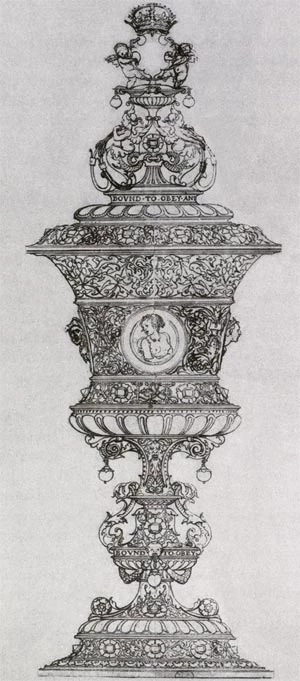A grand cup made from solid Welsh gold
Welsh Gold
The solid gold cup made from a design on a drawing in the British Museum of a cup given by King Henry VIII to Queen Jane Seymour in 1536. Cup and cover, 22 carat gold, R & S Garrard & Co, London 1867-68. Height: 39.8 cm (15 ''/16 in).
Welsh gold is very rare. The wedding rings of today's British Royal family are made from it. The largest object made of Welsh gold is a copy of a cup Henry VIII gave to one of his wives.
The richest family in Wales
The cup was made in 1867 for the Williams-Wynn family of Ruabon in Denbighshire, using gold from their own mine. At the time, they were the richest family in Wales. They were well known for their wealth, which they spent on grand houses, expensive paintings and silver, much of which is now at the Museum.
The Welsh Gold Rush
While many people know of the California gold rush of 1848, few know that, a few years later, there was a Welsh gold rush. In 1862 gold was discovered in Merioneth and, soon after, Sir Watkin Williams-Wynn (1820-1885) opened the Castell Carn Dochan mine on his land. The mine produced most of its gold between 1865 and 1873.
Payment in Gold
Sir Watkin was paid a large royalty for the gold mined, and he was paid with his own gold ingots. However, he was rich enough not to need this income, and could treat this gold as a novelty.
A Cup of Solid Gold
Some of this gold was used to make a magnificent cup. The cup is nearly 40cm high and made of 22-carat gold. It is inscribed "MADE OF GOLD THE ROYALTY FROM CASTELL CARNDOCHAN MINE 1867" and hallmarked by R & S Garrard and Co., Haymarket, London. It is ornate, in the style popular in the early Renaissance period. It stands on a circular foot, and the stem is flanked by flower heads, dolphins and bells. The cup is inscribed with several family mottoes: eryr eryrod eryri ('the eagle of the eagles of Snowdonia'), y cadarn ar cyfrwys ('the strong and the sly'), bwch yn uchaf ('the ram is on top') and cwrw da yw allwedd calon ('good beer is the key to the heart'). The tall lid has the Williams-Wynn arms, including a young ram on top, supported by a pair of cherubs.
A Royal Design for Henry VIII
The original design for the cup given to Queen Jayne Seymour in 1536-37 in the British Museum. Hans Holbein the Younger, pen and ink on paper. Copyright British Museum, London
The makers of the cup based the design on a drawing in the British Museum of a cup King Henry VIII gave Queen Jane Seymour in 1536. This cup was set with diamonds and pearls. Jane Seymour's cup was melted down on the orders of King Charles I in 1629, when he was desperate for cash.

